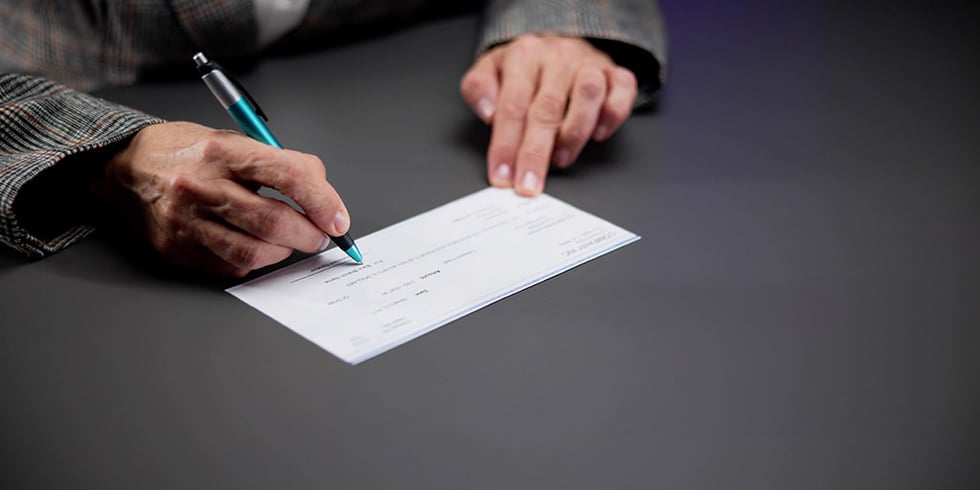In the digital era, one type of noncash and non-digital payment is still being used for transactions worth trillions of dollars across the globe.
If you guessed it to be bank checks, you are absolutely correct!
Accounting for approximately 21% of the overall noncash payments, checks cashed a total value of $27.23 trillion in 2021 for the US market.
The landscape of financial transactions is a continuously evolving one, and recent trends point to a notable shift in the usage and risks associated with check payments.
While the Federal Reserve Payments Study indicated a consistent decline in the overall number of check payments, with an annual reduction rate of 7.2% since 2018, the total value involved in these transactions remains substantial.
Why Are Frauds Increasing When Check Usage is Declining?
However, despite the decreasing use of checks, the threat of check fraud not only continues to persist but is also escalating. This is due to the high value typically associated with individual check transactions, which seems to have rendered them more susceptible to fraudulent activities.
Data from the Financial Crime Enforcement Network (FinCEN) underscores this concern, revealing a stark increase in Suspicious Activity Reports (SARs) related to check fraud. In 2021, over 249K such reports were filed, this number more than doubled to 501K SARs filed in 2022 and further went up to 528K SARs in 2023.


Source -SAR Stats | FinCEN.gov
This increasing number of cases continues to create several check fraud processing challenges such as backlogs in check warranty claims, availability of funds and the average check fraud value doubling over the last decade.
For instance, Frank McKenna, chief fraud strategist at Point Predictive, had told the website BankInfoSecurity.com that he expected check fraud to hit $24 billion or more in 2023.
The types of check fraud schemes are diverse and complex. The following section delves into the factors contributing to the complexity of check fraud, highlighting their unique characteristics and the challenges they pose.
- The Multi-Channel Challenge:
Checks are deposited through various channels, each presenting distinct detection hurdles. Traditional methods like mail and teller services have limitations, while newer options like remote deposit capture and ATMs introduce anonymity and reduced monitoring. This diversity creates a complex landscape for fraud prevention. - Washed Away, Forged Anew:
Check washing, a common tactic, involves erasing the original payee information and replacing it with fraudulent details. Stolen checks are often targeted, with criminals utilizing chemical or technological methods to "wash" the ink. This scheme can involve altering the amount and even creating copies for further distribution.

- From Mailbox to Mayhem:
The rise in mail theft poses a significant threat to check security. Criminals, emboldened by a surge in incidents and the availability of master keys online, target mailboxes to steal checks.
This is particularly concerning given the recent increase in government payments delivered via checks, creating a lucrative target for fraudsters. For instance, on Feb. 27, 2023 FinCEN published an alert highlighting the nationwide surge in mail-theft-related check fraud. From March 2020 through Feb. 2021, the United States Postal Inspection Service received 299,020 mail theft complaints, an increase of 161 percent compared with the same period a year earlier.
There has also been a significant increase in armed robberies and assaults of U.S. Postal Service workers. The target? Their master keys, which can open mailboxes in building lobbies and those on streets.

Source -FinCEN published an alert
- Counterfeit Creations:
Stolen checks are traded in shadowy online markets, shielded by encryption and anonymity. This poses challenges for law enforcement and necessitates vigilance from financial institutions and consumers. Criminals exploit encrypted communication platforms to sell stolen checks without leaving a trace.
Counterfeit checks, often containing real account numbers, are fabricated to resemble legitimate documents. Fraudsters may advertise for "money mules" online, who then cash or deposit these checks using fake identities matching the payee information. Stolen checks can also serve as templates, with routing and account details copied to create new counterfeits. - Beyond the Check:
The impact of check fraud extends beyond the immediate financial loss. Stolen checks can expose personal information, potentially leading to further identity theft and credit card fraud. This highlights the need for comprehensive security measures across all aspects of check handling and processing.
The good news?
We're not defenseless. By employing a multi-pronged approach, including trained specialists, global monitoring, advanced analytics, and AI-powered check verification tools, financial institutions can significantly reduce fraud and protect both themselves and their customers.
So how do we do that?
Coforge Fraud Engine
Our fraud engine performs validations on the scanned cheque images (handwritten or printed) using our Vision AI engine and helps raise fraud alerts with extremely high level of accuracy. Our tool can detect anomalies in
- Check Borders
- Details of maker, payee, bank logo/details, endorsements, and rest of all printed font size, match with history
- Determine payee type and handwriting match from historical checks
- Amount in words and numbers – Handwriting and trend can be compared to historical data
- Validate the check serial number throughout series history
- Determine whether the date is old or not
- Signature – Handwriting, flow, and strokes must match with historical items or signature card
- MICR Line – Compare the routing number and account number from previous checks
- Number Series, Endorsements etc. are extracted and validated against Core Banking Applications
Our tool can be integrated with various banking applications via APIs/Data feeds with ease. Coforge SME expertise augmented with validations performed by our AI engine can significantly improve the detection of fraudulent cheques and assist in reducing false positives.
Check Fraud Verification Process Enhanced with the Coforge Fraud Engine

- Trained Experts: Coforge BPS can provide a team of highly trained specialists with deep expertise in identifying and investigating check fraud schemes. Our teams of check fraud specialists are supporting multiple banks across products like positive pay, check fraud and account reconciliation.
- Global Footprint: By leveraging the time difference between the US and our offshore delivery centers, banks can achieve round-the-clock monitoring and analysis of check transactions, potentially catching fraudulent activity sooner. Leveraging the time difference, our teams can offer faster investigation and response times to suspected check fraud cases, minimizing potential losses for banks.
- Cost Efficiency: Leveraging our offshore check fraud specialists, banks can not only save the additional financial burden caused due to surge in check fraud activity, but they can also save potential losses and charge offs by reducing the dollar threshold limits and adding capacity to scrub checks below the current thresholds. This strategy has helped our existing clients save a large part of charge-offs.
- Scalability: We can scale our workforce up or down rapidly based on the specific needs of each bank, allowing for flexible and cost-efficient resource allocation.
- Advanced Analytics: We can also leverage advanced analytics tools and machine learning algorithms to identify suspicious patterns and activities that might be missed by traditional methods.
Enhancing Fraud Detection Efficiency: A Case Study by Coforge
Introduction:
A leading regional banking client of Coforge BPS faced an $8 million annual loss due to counterfeit checks, lacking comprehensive fraud detection capabilities. With 50,000 daily checks, only 40% of alerts could be processed promptly.

Challenges:
- Legacy tool limitation
- Time-sensitive processing
- High volume of alerts
- Escalations for bank verification
Solution:
Recognizing the urgency to address these challenges, Coforge embarked on a process re-engineering initiative. The key components of the solution included:
- A strategic approach to prioritize critical queues, ensuring that high-risk alerts are addressed promptly
- Employee trained across multiple functions to enhance efficiency and speed in fraud detection and verification processes
- Leveraged the global footprint of the team to reduce TAT by starting much earlier in the day vs. the onshore team
- The Coforge team designed a lean-based processing approach to reduce escalations for bank verification by 15%
Results:
- Detected $45 million of fraud
- Reduced TAT by 50% (from 14 to 7 hours)
- Detected $100 million fraud in four years
- Maintained 5/5 C-SAT rating
Follow the link to know more: Check fraud of ~$45MN saved over last 4 years for a Top 40 U.S. Bank
About Coforge
Coforge is a global digital services and solutions provider, that leverages emerging technologies and deep domain expertise to deliver real-world business impact for its clients. A focus on very select industries, a detailed understanding of the underlying processes of those industries and partnerships with leading platforms provides us a distinct perspective. Coforge leads with its product engineering approach and leverages Cloud, Data, Integration and Automation technologies to transform client businesses into intelligent, high growth enterprises. Coforge’s proprietary platforms power critical business processes across its core verticals. The firm has a presence in 21 countries with 26 delivery centers across nine countries.
Learn more at www.coforge.com
Discover Sandeep Narang's expertise on Coforge's blog. Gain knowledge on digital transformation and business innovation.
Related reads.

About Coforge.
We are a global digital services and solutions provider, who leverage emerging technologies and deep domain expertise to deliver real-world business impact for our clients. A focus on very select industries, a detailed understanding of the underlying processes of those industries, and partnerships with leading platforms provide us with a distinct perspective. We lead with our product engineering approach and leverage Cloud, Data, Integration, and Automation technologies to transform client businesses into intelligent, high-growth enterprises. Our proprietary platforms power critical business processes across our core verticals. We are located in 23 countries with 30 delivery centers across nine countries.



